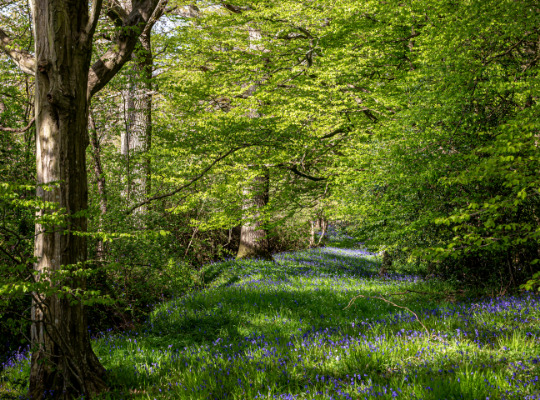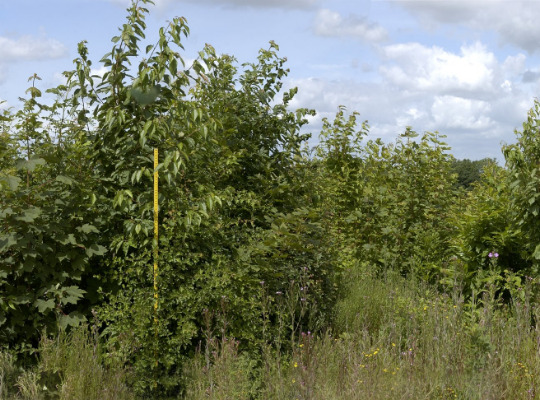The climate is changing, and will continue to change, and the advice is to plan for a 2 °C global temperature rise (above that of the pre-industrial period), and to consider the risks from a 4 °C temperature rise before 2100 in adaptation planning (CCC, 2019).
Summers are projected to become warmer and drier, and winters warmer and wetter, with an increase in extreme events, including droughts and storms. The climate emergency will affect our forests and woodlands. It will alter the growth of trees, the wildlife habitats and other ecosystem services they provide. Many owners have already noticed environmental changes in their woodland.
All types of forest and woodland will be affected by climate change. For some, the changing climate may lead to an increase in growth, where other factors are non-limiting (i.e., water and nutrient availability). However, for many other sites, the suitability for different tree species may decline, and their growth will reduce. Climate change is increasing the likelihood of stand damage or loss from drought, wildfire, flooding, wind throw, pests and diseases. The rate of change is such that some trees may not thrive and may not even survive. This will affect the ecological processes in the woodland ecosystem, such as pollination and nutrient cycling for example, so that under certain circumstances, it will be necessary to intervene to ensure continued woodland function.
It is therefore important to assess risks from climate change to each forest and woodland to establish what actions to take. Planning management so that changes continue to occur naturally with limited active intervention may be the best approach in some situations. However, future resilience is more likely if adaptation measures are identified and taken, for example, contingency planning for changing wildfire risk or exploring alternative stand establishment methods for changing drought risk.
There are many ecological benefits from actively managing woodlands; taking the risks from changing climate (including pest and disease risks) into account when management planning and proactively selecting adaptation measures will support effort to improve resilience.

It should be possible to identify opportunities to promote different species or habitats rather than accept the loss of features of interest. Such alterations may need to be reflected in the definition of ‘favourable condition’ for a designated site (e.g., Site of Special Scientific Interest), in which case the appropriate national conservation body should be consulted.
Where priority is given to important or protected habitats, guidance from the statutory nature conservation agencies will set out what is known about the potential sensitivity of woodland habitats. For example, refer to the second edition of Natural England and RSPB’s Climate change adaptation manual: Evidence to support nature conservation in a changing climate, which describes the potential sensitivity of a range of habitat types, including the main woodland habitats.
Ancient and semi-natural woodlands (ASNW) have particular characteristics, such as the high biodiversity that includes many specialist woodland species and a high proportion of rare and vulnerable species, both above and below ground. They typically have high carbon stocks, and their soils are usually well-developed and undisturbed, providing high rainfall infiltration capacity. They are often highly valued culturally and are important heritage assets, and their preservation is often intimately linked with traditional management techniques. However, they are at particular risk from climate change due to their fragmentation and typically small size with the consequent high proportion of trees exposed around the edges. In addition, the age and fragility of many of the trees increases the risk of damage from wind or floods, and their unique species assemblages increases the risks from invasive species and pests and diseases.
The risk of extreme events and tree health threats that can cause stand damage and/or mortality is increasing for all forest types. The changing or new risks of drought, wildfire, storms, flooding, pests and diseases must be assessed, and appropriate adaptation measures implemented.
Changes in the whole vegetation community structure are likely because of altered plant competition caused by changes in light from increased leaf area and earlier leafing, increases in growing season temperature, and drier soil conditions in many woodland types during the summer months. It will therefore be important to consider the changing climate in the management of ancient, semi-natural and native woodland and to develop management and contingency plans to deal with impacts. It may also be necessary to adjust the management objectives for the site if, for example, species suitability changes.

Climate change will affect where habitats and species are found and their composition. For example, species adapted for cooler conditions may alter their range to higher elevations in the uplands and species limited by low temperature at the northern edge of their range may extend further north. Projected changes in climate will affect tree growth rates. For sites where the climate will become less suitable for particular tree species, growth rates will reduce and impact the potential for ecosystem services such as carbon storage and sequestration, flood protection, and habitat provision for wildlife. Planning for long-term changes in climate is essential.
The changing climate will affect each site differently. Assessing the site-specific risks and interactions between multiple risks is essential, by refining projections to the stand level and integrating local knowledge. Adaptation to climate change is more than identifying alternative tree species, although that can be an important component. There is a growing appreciation of the wider range of adaptation measures needed to adapt current stands to future changes and to adapt to specific risks. For example, alternative establishment methods, restructuring, transitioning to a continuous cover system, management of vegetation for wildfire and contingency planning are some of the potential adaptation measures to be explored.
The Ecological Site Classification (ESC) decision support tool can support decision-making by assessing the current and future suitability of tree species for a site, including sites supporting ecological objectives. Information about alternative species and management systems, are available, as is guidance for managing specific risks.
Pioneering private woodland owner Mr Sclater created a 3ha plantation in Sussex in 2017 that is designed to be resilient to climate change in 2217!
Adaptation measures have helped enhance resilience to both pests and diseases and climatic stresses in this 80 hectare SSSI woodland in the Midlands.
Information about adaptation of specific protected woodland habitats in the UK can be found in guidance from agencies, for example the adaptation manual from Natural England and RSPB Climate change adaptation manual: Evidence to support nature conservation in a changing climate.
Information and advice on the management of threats to woodland, including deer, squirrels and invasive non-natives, is available from www.gov.uk/guidance/manage-threats-to-woodland-destructive-animals-invasive-species#other-invasive-species